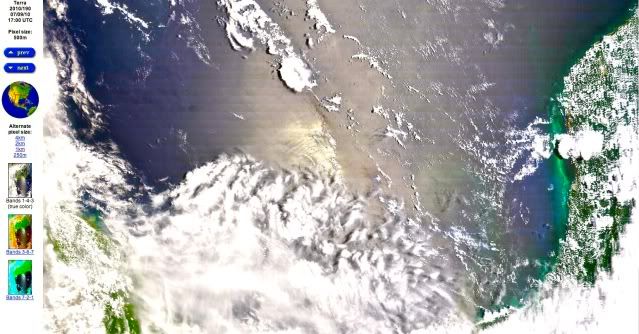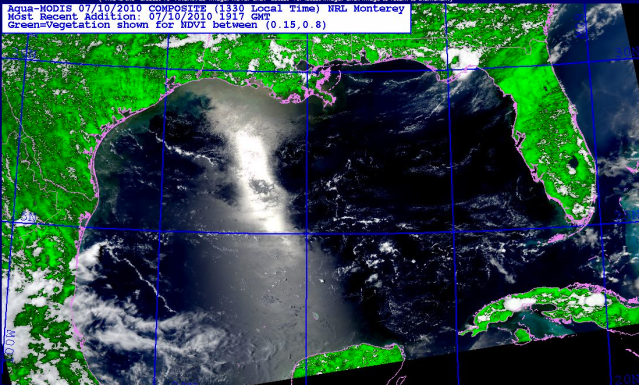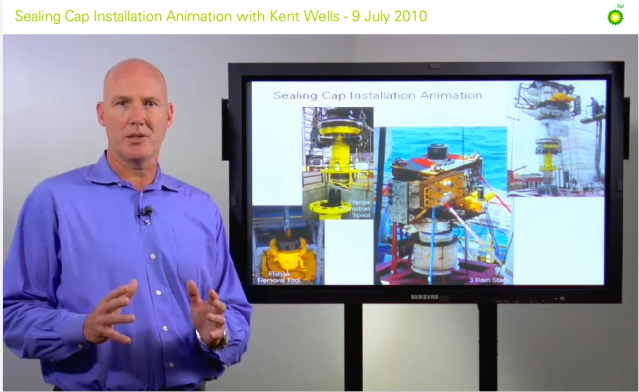Just when you thought we were up to our a$$es in oily alligators, the Obama Administration Department of the Interior announces plans to open 1.8 million acres of Alaska’s National Petroleum Reserve to bidding on 190 new tracts for NEW OIL AND GAS DRILLING. Bidding will open Aug 11.
Gotta Love Grist. Called it The Dept of Not Learning. http://www.grist.org/article/2…
It’s only another 1.8 million acres.
http://interior.gov/news/press…
Increases number of oil/gas wells by 60% from 310 to 500.
Increases number of acres under drilling by 60% from 3 million to 4.8 million
Teshekpuk Lake is 80 miles east of Point Barrow on the northern Alaska coastline, which is already being damaged by the warming climate and melting arctic sea ice. Up to 90,000 geese use the area to molt every summer, and the Indigenous people use part of the local caribou herd to survive by subsistence hunting.
http://en.wikipedia.org/wiki/T…
____
The BP Oil Slick is Blowing Towards Texas. Here’s the satellite image from NASA, Friday, July 9th, from 1 km up in space
http://rapidfire.sci.gsfc.nasa…

Friday, July 9, 2010. Oil slick heads west towards Texas coast. photo NASA

Oil Slick now extends south all the way to the east of the Yucatan Peninsula in Mexico. This is the bottom half of the same image of the Gulf of Mexico on 7/9/10 as above. photo NASA
photo from today, Saturday July 10, 2010
Today, July 10, 2010, Gulf of Mexico. Winds are now shifting to come out of the west/southwest again after an east wind drove this oil towards Texas earlier this week. But the oil to the south near the Yucatan peninsula, is probably going to continue to go west, then north again, with the natural Gulf clockwise current. photo, NRL Monterey, biomass, satellite Aqua
__
Cap on, Cap off, Cap on ?
I’ve mentioned previously that the condition of the sawn off riser stub on top of the Blow Out Protector looks to be deteriorating when they’ve had the LMRP Cap which sucks the oil up to the Discover Enterprise, taken off temporarily. And certainly the little bouncing Cap itself has taken a beating from being at the end of nearly a mile of pipe suspended from above over an oil and gas volcano, while 10 foot storm waves were rocking things at the top. Now, a day after Adm. Thad Allen sent BP ” the letter,” (short version: the clock starts now. make up your mind BP, or we will make it for you) it looks like they are going to take some drastic action. And that means that as of this morning, the riser pipe stub on top of the well’s BOP is once again butt naked and spewing oil unimpeded.
like this. Today, at 1:39 pm PDT. Here we go again.
___
Video fr CNN
http://www.cnn.com/video/data/…
Adm Thad Allen on Friday July 9th: (where Adm. Allen was speaking tech shorthand, I have added note: a word or phrase for clarification)
We are in the process of hooking up a third production platform the Helix Producer, delayed because of the last weather front. Hookup is in progress today, hope finish testing for leaks, possibility will produce out of it on Sunday.(note. the new “Helix Producer” will suck oil taken out of manifold assemblies added to the existing BOP on the sea flow, below the riser pipe, just as the Q4000 does currently. By “produce” he means gathering oil and gas from this new one.)
This raises total capacity for our current containment cap system to 50 -53,000 barrels day.
(note: as of today they have been gathering about 25,000 barrels a day on a good day from the leaking well)
Could start removing current cap on the well bore tomorrow (Saturday July 10th) followed by a period with no cap. Then would produce (oil & gas) thru Q4000 and the Helix Producer . There would be a multi day period where there would be no capping device, (a period where we would only be the Q4000 and the Helix gathering out of the lower part of the BOP) …. and the environment exposed to petroproduct (note: he used “hydro carbons going into the environment”)
Re: Relief wells, progress, one at 17,830′ feet getting very close . Things get slow at this point go in small sections. Drill, withdraw, put a sensor down, assess distance horizontally to the well bore.
Sometime in the next week or so should be able to assess where to drill into the annulus, which is a circular area outside the drill pipe, and assess if any hydrocarbons (oil & gas flowing up) are there, and first opportunity to fill the wellbore with mud to defeat the pressure of the hydrocarbons. if no hydrocarbons present there, they will cement plug that outer (annulus empty) ring , let dry, then go back into the drill pipe. could be a two phase process. if they have to do both phases, takes us into the middle of August.
Our conservative estimate is that it will take it into the mid of Aug until we have actually capped the well. Could be sooner, would be delighted if it could be, but
govt. estimate continues to be middle of August.
I think once we have the new cap, we should be able to get the most accurate flow rate to date based on the actual pressure in the well. ”
__
end transcript of Allen’s press conference from above link.
__
Later the government’s Deepwater Horizon Unified Command issued a clarification.
http://ht.ly/29B91
Fri July 9 2010 20:57 CST aka 3:57 pm CST
National Incident Commander Admiral Thad Allen.“After reviewing Bob Dudley’s response to my July 8th letter, outlining BP’s proposed plan of action for oil containment efforts, and consulting top government scientists and engineers including Secretary Chu,
I approved BP’s plan to simultaneously install the Helix Producer and “capping stack” containment mechanisms,
which will require temporary suspension of the current top hat containment system.I validated this plan because the capacity for oil containment when these installations are complete will be far greater than the capabilities we have achieved using the current systems. In addition, favorable weather
expected over the coming days will provide the working conditions necessary for these transitions to be
successfully completed without delays.The transistion to this new containment infrastructure could begin in the next days but will take seven to ten days
to complete. I have also directed BP to provide daily briefings and regular informational updates to the media
thoughout this process.”
__
There are several ways to interpret this decision to take advantage of a spell of relatively calm Gulf of Mexico weather.
All of them point out that they think the the relief wells are not a sure thing to be able to plug the leak, and that the current system is woefully inadequate to capture but about a third to perhaps half of the oil and gas spewing from the well – aka the vague term “far greater than the capabilities we have achieved….. ”
And it looks like the little LMRP Cap #4 has come to the end of its lifetime warranty and they didn’t want the potential of a big slug of drill mud shooting from the relief well coming up and ruining an oil gathering cap…. oh, wait…. hope they have another spare.
Adding another “capping stack” successfully, is truly going to be a hair raising experience, because they are planning to switch out part of the very top of the existing riser pipe stub and flange. They have to loosen 6 giant bolts, remove them, then bolt a new a new connection onto the top. The name of the ship that will be over this operation is the “Discoverer Inspiration.” Discussion and links here at the Oil Drum:
Hooking up Helix and Plans for New Cap 7/10/10
http://www.theoildrum.com/node…
More on the relief well process, including illustrations you really ought to see:
Adding Mud to the Well
http://www.theoildrum.com/node…
__
BP is referring to the new thing as a “sealing cap.” The whole thing is also called a “stacking cap.” Or the 3 ram stacking cap. Yesterday’s harvest with the old cap as part of the works, was about 24,790 barrels. BP claims to have captured or flared 755,900 barrels of oil, on its website today. If the spill rate was 50,000 barrels a day, that means at 80 days on July 9, they’ve gotten 18% of the 4 Million barrels spilt. If the spill rate was higher, say, 80,000 barrels a day, to 6.4 Million barrels, it would be a catch of 11.8 % of the total oil let loose by the blow out.
I believe this is why they have been so gung ho on continued dispersant use, which ends up ultimately sinking a lot of the oil, never to be seen, because nearly 3 months later, at day 80, they are only capturing 11.8% to 18% of the spewing oil.
Per BP’s Kent Wells (yes, that is the guy’s name) technical update today,
the sealing cap has the potential to increase oil and gas collection capacity and should improve collection efficiency during hurricane season by allowing shorter disconnect and reconnect times. The new cap assembly should have a positive impact on future well kill and cementing procedures that will be part of the relief well operations. In addition, the new cap should enable testing of well integrity and, depending on pressure measurements, may be used to shut in the well.
A video animation of the entire “Sealing Cap” procedure is here:
http://bp.concerts.com/gom/sea…
BP’s Kent Wells. Yes, that’s ” it ” in the middle. what could possibly go wrong ?
webcams for slower connections: http://www.occupantunknown.com…
“Ocean Intervention III” ROV 2 has the camera that’s watching the BOP top now. Looks like ROV 1 just went to that view, also.
___
The text of Adm. Allen’s July 8th letter to BP pdf here: http://www.deepwaterhorizonres…
excerpts:
BP will provide me a detailed contingency plan for resuming source recovery at the riser should the mounting of the capping stack fail.
BP will provide me with a detailed plan for pressure testing the well and transitioning from collection from the capping stack to shutting in the well using the capping stack.
BP will provide me with a detailed plan, keyed off the timelines developed under paragraphs 1 through 2, outlining operations to maximize management of oil reaching the surface…. the use of dispersants will be minimized at all times consistent with the need to address VOC exposure issues for workers at the Deepwater Horizon site….
BP shall obtain my approval before any actions are taken on each of the decision points subsequently identified.
Admiral Allen is either going to be the hero or the goat on this one.
__________________________
In good news, actor/inventor/humanitarian Kevin Costner’s “Ocean Therapy” Oil skimming centrifuge has become reality, and a unit and boom has been installed on a barge named “Ella G” to begin skimming oily water, taking the oil out, and returning cleaned water to the sea. Someone at the Oil Drum estimated it might be able to remove 2,000 barrels of oil a day. This is 2,000 barrels more a day than any of Costner’s detractors have ever done. Go Waterworld !
_____________
edited 6 times to find paragraph from the government JIC website which does not cut and paste into this format. Retyping it manually works, fyi. phew!




2 comments
on such dismal news…
Thanks,
Diane